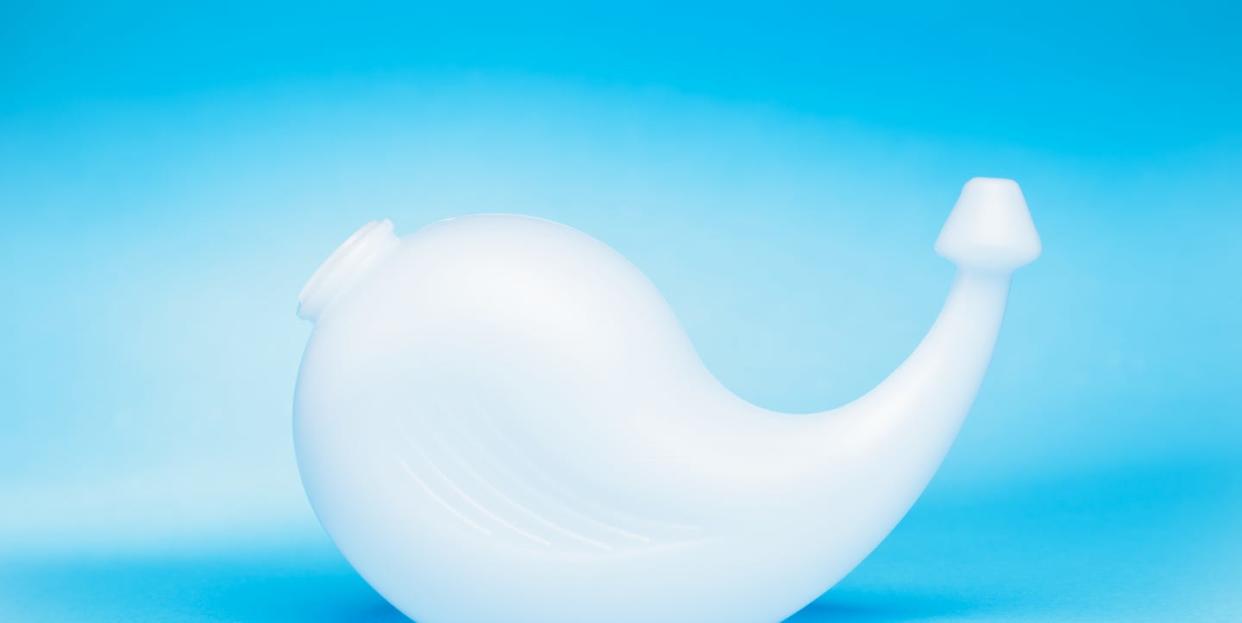Why You Should Never, Ever Use Tap Water In Your Neti Pot

"Hearst Magazines and Yahoo may earn commission or revenue on some items through the links below."
When you have a stuffy nose that won’t quit, you’ll do anything to feel better. That includes reaching for nasal irrigation tools like a neti pot to try to flush out your sinuses.
But while neti pots have developed a cult following among people with sinus issues, it’s fair to wonder if neti pots actually work. Here’s what doctors actually think about these handy tools and other nasal irrigation methods.
What is a neti pot, exactly?
A neti pot is a type of nasal irrigation that involves using a tool that looks like a little teapot. These devices are filled with saline solution and flushed through your sinuses to try to treat congested sinuses, colds, and allergies, according to the Food and Drug Administration (FDA).
“Neti pots introduce a saline solution into the nasal passages to rinse the inside surface of the nose,” says Tiffany Owens, M.D., an allergist/immunologist at The Ohio State University Wexner Medical Center.
How does nasal irrigation with a neti pot work?
Neti pots essentially wash out your nose, says Benjamin S. Bleier, M.D., a rhinologist/otolaryngologist at Mass Eye and Ear. To use a neti pot, you fill the container with boiled or distilled water. Then, tilt your head to the side over a sink and gently pour the water into the upper nostril while breathing through your mouth. It will flow into your sinuses and drain out the lower nostril.
“Neti pots work by gravity,” Dr. Bleier explains.
So, do neti pots work?
Actually, yes. Neti pots “are among the best studied and most effective non-pharmacologic method to clear mucus and debris from the nose,” Dr. Bleier says.
One randomized controlled trial of 68 people with viral upper respiratory infections found that 93% of those in the nasal irrigation group thought rinsing out their sinuses made a difference in their symptoms. Researchers also noted that those in the neti pot group were sick about two days less than those who didn’t do nasal irrigation and used over-the-counter medicine 36% less.
Another study of 747 people found that nasal irrigation helped people with allergy symptoms, including nasal congestion, runny nose, itching, and sneezing. And an older study of 400 children with colds or flus in the Czech Republic found that those who used neti pots several times a day had their symptoms clear up faster and were less likely to use medications or antibiotics than those who didn’t do nasal irrigation.
But Dr. Owens says that the effectiveness of neti pots is “somewhat person-dependent.” She adds, “If there is mucus or debris in the nasal passage, they can be very effective. If there is a blockage in the nose—such as a deviated nasal septum or a polyp, rinsing may not be very helpful.”
Are neti pots safe?
When they’re used as directed, neti pots are considered safe to use. “The bottles should be cleaned after each use and the water used should be boiled or distilled,” Dr. Bleier says. But they can be dangerous if you don’t follow the instructions.
The FDA specifically warns about the risk of using tap water for nasal irrigation. Why is this problematic? It’s not properly filtered or treated, and some tap water contains low levels of organisms, like bacteria and protozoa (including amoebas). These may be safe to swallow because your stomach acid kills them, the FDA explains. But when they end up in your nose, they can stay alive and potentially cause very serious and even deadly infections.
In rare cases, people have actually died from using a neti pot filled with tap water. One terrifying case report published in the International Journal of Infectious Diseases tells the story of a 69-year-old woman who died from a brain-eating amoeba after using filtered Brita water in her neti pot.
The FDA specifically lists the following as safe forms of water you can use in your neti pot:
Distilled or sterile water, which you can buy in stores. (The label will clearly say “distilled” or “sterile.”)
Boiled and cooled tap water (boiled for three to five minutes, then cooled until it's lukewarm).
Water passed through a special filter designed to trap potentially infectious organisms.
When to use a neti pot over a saline spray
In general, Dr. Bleier says he typically recommends nasal irrigation over saline sprays. “Sprays don’t do a good job penetrating past the front part of the nose,” he explains. “I would generally recommend an irrigation with a neti pot or squeeze bottle.”
The only exception, he says, is if you’re trying to treat dryness in your nostrils or the front part of your nose.
“Neti pots use more volume. They are better for rinsing,” Dr. Owens says. “Saline sprays are better for helping to add some moisture to the nasal passages or for individuals who cannot tolerate larger volumes of fluid.”
If you’re struggling with congestion and aren’t sure if a neti pot is right for you, talk to your doctor. They should be able to provide guidance.
You Might Also Like

